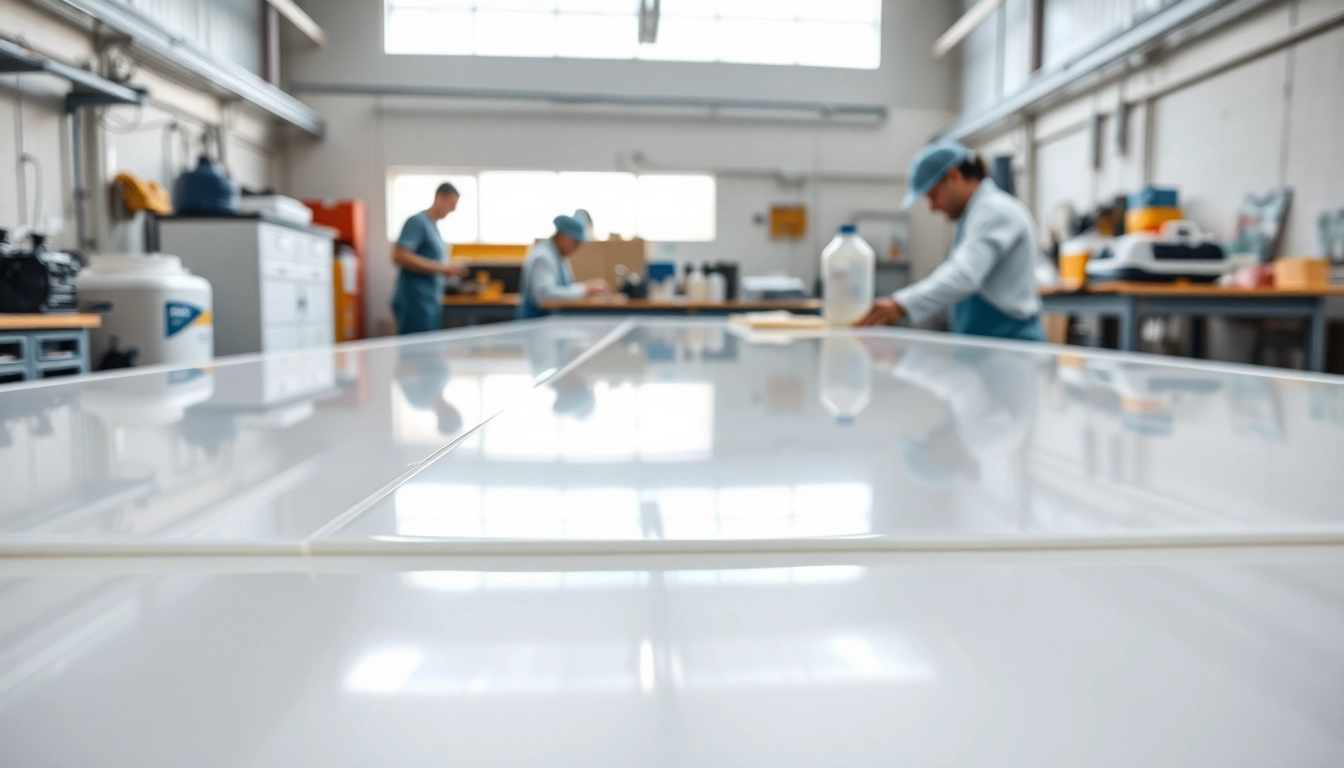Understanding Laminating Resin: What You Need to Know
Laminating resin is a crucial material widely utilized in various industries, serving as a binder for niche applications that require durability and reliability. From marine construction to crafts, understanding the properties, types, and applications of laminating resin can help one optimize project outcomes effectively. This guide explores everything you need to know about laminating resin, its applications, and best practices for ensuring successful results in your projects. For those looking to explore options and find the ideal solutions, laminating resin offers promising solutions tailored to different needs.
What is Laminating Resin?
Laminating resin is a type of polymer-based material that is primarily used to bind together layers of different materials, typically fiberglass or carbon fiber, to create composite materials. These resins are designed to remain tacky during the application process, ensuring maximum adhesion and strength. Laminating resin is commonly characterized by its flexibility, resistance to environmental elements, and ability to create a strong bond between layers, providing structural integrity and performance advantages.
Types of Laminating Resin Available
There are several types of laminating resins available in the market today, each formulated for specific applications and materials. The most common types include:
- Polyester Laminating Resin: Known for its versatility and cost-effectiveness, polyester laminating resin is widely used in marine manufacturing and various applications where a strong but affordable composite is required. Its fast curing time makes it a popular choice for projects requiring quick turnaround.
- Epoxy Laminating Resin: This type of resin is prized for its superior grip, durability, and resistance to moisture and chemicals. Epoxy laminating resin offers excellent mechanical properties and is ideal for applications requiring high strength and enhanced performance.
- Vinylester Laminating Resin: Combining the best properties of both polyester and epoxy, vinylester laminating resin is renowned for its resistance to corrosion and high strength. It is commonly used in the creation of high-performance composites in industries like marine and automotive.
Key Properties of Laminating Resin
Laminating resin comes with several key properties that make it suitable for varying applications:
- High Adhesion: Laminating resins are formulated to create strong bonds between layers, which is crucial for reinforcing the overall strength of the composite material.
- Flexibility: The ability to flex without breaking makes laminating resin ideal for applications that require movement or expansion, such as in marine and automotive parts.
- Weather Resistance: Many laminating resins are resistant to water, UV radiation, and chemicals, which makes them suitable for outdoor and high-stress environments.
- Tack Property: The tackiness of laminating resin allows layered materials to stay in place during the curing process, which is essential for creating reliable composites.
- Fast Curing: Most laminating resins cure quickly, helping to speed up production processes and project completion times.
Applications of Laminating Resin in Various Industries
Laminating Resin in Marine Manufacturing
The marine industry extensively utilizes laminating resin for constructing boats, yachts, and other watercraft. Laminating resin provides the strength needed to withstand the harsh marine environment while maintaining a lightweight structure, which is essential for performance on the water. Projects often involve reshaping molds and layers of fiberglass reinforced with laminating resin, ensuring they can handle water pressure and resist corrosion from saltwater exposure.
Laminating Resin in Furniture Production
In the furniture industry, laminating resin is employed to create durable, moisture-resistant surfaces. It is often used in combining layers of wood and other materials, enhancing the furniture’s overall lifespan while providing an attractive finish. Applications include tables, cabinets, and custom pieces that require a strong, finished appearance that is also resistant to scratching and fading.
Laminating Resin for Crafts and DIY Projects
Laminating resin has become increasingly popular in the crafting community, providing hobbyists with the ability to create artistic projects, home decor items, and custom jewelry. Its versatility means it can be used for casting, sealing, or coating items, which not only protects them but also enhances their visual appeal. Options for color mixing and embedding materials like flowers or glitter make laminating resin a favorite among DIY enthusiasts.
Factors to Consider When Selecting Laminating Resin
Viscosity and Curing Time
Choosing the right laminating resin starts with an understanding of its viscosity and curing time. Lower viscosity resins tend to flow better and are easier to work with in intricate applications; however, they may require careful handling during the curing phase to ensure adequate adhesion. Curing time is equally critical, as faster-curing resins can save time on projects but may require a more accurate setup to avoid bubbles or weak layers.
Strength and Durability Ratings
Different projects require different strengths; hence, evaluating the strength and durability of your chosen laminating resin is essential. This often correlates with the resin type—epoxy is generally regarded for higher strength applications—while polyester may suffice for standard uses. Understanding the potential stresses a finished product will endure can help inform this choice.
Resistance to Environmental Factors
Another significant consideration is how well the laminating resin holds up against environmental factors like humidity, temperature, and UV exposure. Marine and outdoor applications necessitate high resistance to water and UV rays, whereas indoor projects may focus on aesthetics and ease of use. Selecting a laminating resin designed for specific conditions ensures longevity and integrity in the final product.
Best Practices for Working with Laminating Resin
Safety Precautions and Tools Required
Working with laminating resin requires specific safety precautions to protect oneself from inhalation or skin contact. Always work in a well-ventilated area, utilize protective gloves and eyewear, and consider wearing a mask if the resin emits fumes. Essential tools typically include mixing containers, stir sticks, and brushes for application, while safety gear should always be prioritized.
Step-by-Step Application Guide
Applying laminating resin can vary based on the project, but typically follows these steps:
- Preparation: Clean and prepare the surface to ensure proper adhesion. Remove any dust, oils, or contaminants.
- Mixing: Carefully measure and mix the resin according to the manufacturer’s instructions, ensuring proper ratios of catalyst and resin.
- Application: Use a brush or roller to apply the resin evenly to the first layer, being cautious to prevent bubbles.
- Layering: Add subsequent layers as directed, allowing for appropriate curing time between each layer.
- Curing: Allow the resin to cure completely before handling the final product. Check for temperature and humidity recommendations.
Common Mistakes to Avoid
Knowing common pitfalls can help avoid mistakes during the application of laminating resin:
- Inaccurate Mixing: Not respecting the correct mixture can lead to incomplete curing or a weaker bond.
- Temperature Considerations: Working outside recommended temperature ranges can diminish the resin’s effectiveness.
- Neglecting Safety: Failing to use personal protective equipment can lead to health risks.
Evaluating Performance and Results of Laminating Resin Projects
Performance Metrics to Monitor
To gauge the success of laminating resin applications, monitoring performance metrics is essential. Track aspects such as bond strength, resistance to moisture, and clarity of finish. Visual defects like bubbling or haziness can indicate application issues that need addressing during future projects.
Post-application Maintenance Tips
Once projects are completed, proper maintenance ensures longevity. For outdoor products, regular cleaning with mild soap and water can prevent dirt build-up. Indoor products may require occasional polishing to maintain their finish and appearance. Inspecting regularly for signs of wear will help catch any possible issues before they escalate.
Case Studies: Successful Laminating Resin Projects
Exploring successful case studies can provide benchmarks for quality and performance expectations. Projects that demonstrate the versatility and strength of laminating resin illustrate its importance across industries. Whether it’s a custom boat construction that endures storms or a beautifully crafted table showcasing intricate designs, each project highlights different facets of laminating resin’s application and effectiveness.



